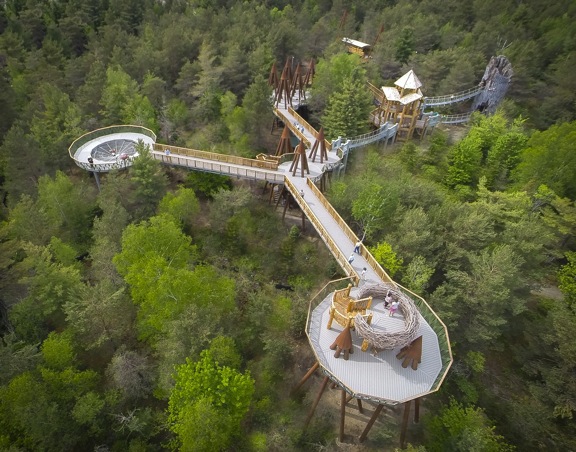WORLD FOCUS: Going on a wild walk

The Wild Walk at the Wild Center in Tupper Lake (Photo provided)
Last year, in a Lake Placid News and Virginia Gazette column, I have reported on the Wild Center, the Natural History Museum of the Adirondacks, in Tupper Lake.
Tupper Lake, once a top lumber producer in New York state, subsequently fell on hard times. Now, the Wild Center, which attracts annually more than 60,000 visitors, is pumping new economic vitality into the life of the town.
Just as Rev. W.A.R. Goodwin, the former rector of the historic Bruton Parish Church in Williamsburg, had the dream of restoring and preserving the 18th century capital city of Colonial Williamsburg, so had Betsy Lowe, a former regional director of the New York State Department of Environmental Conservation, had the dream of creating a natural history museum that would showcase the natural world of the Adirondacks in a comprehensive way.
Goodwin found financial support from John D. Rockefeller, while Lowe raised $28.3 million from 5,237 donors and gained the support of Donald “Obie” Clifford, a descendant of one of the original Tupper Lake lumbering families. Gov. George Pataki also became an enthusiastic supporter of the concept of the Wild Center and helped to funnel state funds to the project.
Now, the Wild Center, in existence for the past 10 years, has added a new $5.5 million attraction, the Wild Walk. It enables the visitors “to look at the wild world from a brand new point of view.”
The Wild Walk is an elevated trail that starts at the ground level and gradually rises to the height of 40 feet. It allows universal accessibility. The visitor, once at the tree-top level, is surrounded by the sights and sounds of the forest. On the way up, the visitor encounter various attractions, such as educational dioramas on wildlife, and view tubes that simulate the hidden world in the trunk of a dead tree.
“The Wild Walk is a new one-of-a-kind experience that is designed to transform the way people can see into the natural world,” states the introductory booklet. “Designed by Charles P. Reay, who was the leading designer of the awardwinning Wild Center, Wild Walk takes people into the heart of a living Adirondack forest.”
The Wild Walk includes a tree house the visitor can explore. It has a spacious platform that is connected by a web of bridges, and raised walkways that twist and turn through the forest. One of the walkways leads to an oversized bald eagle’s nest that features a spectacular view of the High Peaks of the Adirondacks. Then there is an enormous model of a spider’s web, 24 feet above the ground, where youngsters can test their ability for balance. The experience is called, “safely dangerous.” There are dozens of other features that the visitor encounters.
Apparently what makes the Wild Walk such a unique experience is that “Gradually you start to sense the forest around you as if time slowed down and you could see, smell, feel and hear more. When you take Wild Walk, you get to see nature fulfilling every part of the forest with life. …You see food at every turn, and sense the presence of predators large and small. It’s a fantastic and seemingly gravity-free world that hard to imagine, until you get into this Wild Walk where the things we never see or hear or smell are creatively and often artistically illuminated.”
Wild Center Executive Director Stephanie Ratcliffe was quoted saying, “We started out with the concept of birds, but we decided to focus more on the forest.” By all indication, it was the right decision.
Frank Shatz lives in Williamsburg, Va. and Lake Placid. His column was reprinted with permission from the Virginia Gazette. He is the author of “Reports from a Distant Place” a compilation of his selected columns.




